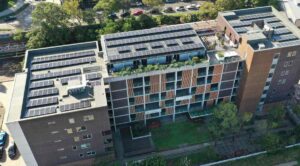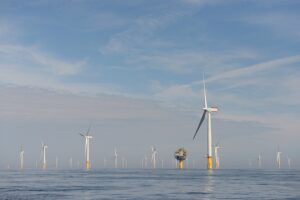The field of wind turbine developers building ever-larger turbines has become a lot more crowded after Chinese clean energy company MingYang Smart Energy unveiled a 16MW, 264-metre tall offshore wind turbine which now rates as the world’s largest.
Boasting a swept area greater than six soccer fields thanks to its 118-metre-long turbine blades, a single 242-metre diameter rotor MySE 16.0-242 is able to power over 20,000 households, generating 80,000MWh of electricity each year.
Importantly, demonstrating the increasingly benefits of scale, the MySE 16.0-242 will produce 45% more energy than MingYang’s previous largest turbine model, the MySE 11.0-203, while only needing a 19% increase in rotor diameter.
“The launch of our new largest wind turbine, MySE 16.0-242, is an apt illustration of the three essential drivers to technology evolution – demand, combination, and iteration,” said Qiying Zhang, President and CTO of Ming Yang Smart Energy, who continues.
“In response to demand for anti-typhoon wind turbines in coastal Guangdong, MingYang systematically develops high-quality products by collaborating with global supply chain partners and integrating cutting-edge technologies from industries such as aerospace, materials, and big data.”
In a way, MingYang has jumped into the ring of offshore wind behemoths from out of nowhere, though that is only because wind turbine development is often bifurcated between Chinese manufacturers, and those in the rest of the world.
MingYang already offers a number of different turbine models – ranging from 5.5MW, 6.45MW, 7.25MW, 8.3MW, to 11MW.
But by announcing what is currently the world’s largest announced offshore wind turbine, MingYang sets itself up as a potential contender to the West’s three largest wind turbine developers – Vestas, Siemens Gamesa, and GE Renewable Energy.
For the past several years, these three developers have been competing with one another to announce, launch, and operate succeedingly larger offshore wind turbines.
As of earlier this year, Danish wind turbine giant Vestas held the record for largest offshore wind turbine with the announcement of its V236-15.0MW turbine.
This beat out GE Renewable Energy’s record-busting Haliade-X turbine – available in 14MW, 13MW, and 12MW options – and nudged out Siemens Gamesa’s 14MW offshore wind turbine.
But the new MingYang MySE 16.0-242 pushes the boundaries once again, with larger blades and rotor yielding a larger swept area and, therefore, increased electricity generation from just a single rotation of its three mammoth blades.
For a comparison of the size of MingYang’s new turbine – which was recently certified by both DNV and China General Certification Center(CGC) for design and is scheduled for full prototype rollout in 2022 – Australia’s tallest skyscraper, the Q1 Tower in Surfers Paradise, Queensland, measures 322.5-metres in height (or 235-metres not measuring the spire). Australia 108 in Melbourne measures 316.7-metres in height, while Melbourne’s Eureka Tower measures 297.3-metres.
All of this height and record-busting measurements might seem meaningless – just another company reaching for an irrelevant record – but the reality is that the taller and more powerful these offshore wind turbines get, the cheaper offshore wind generation will become.
For example, 5 years ago to build a 160MW offshore wind farm you would have needed 16 wind turbines – which would therefore necessitate the construction of 16 foundations, and the installation of 16 wind turbines.
When the MySE 16.0-242 reaches commercial production in the first half of 2024, however, that same wind farm will need only 10 turbines – and, therefore, only 10 foundations and the installation of only 10 turbines. The result is the same power generation but at a reduced cost.










